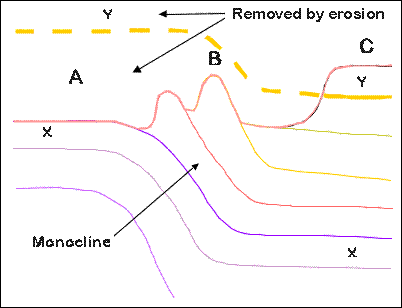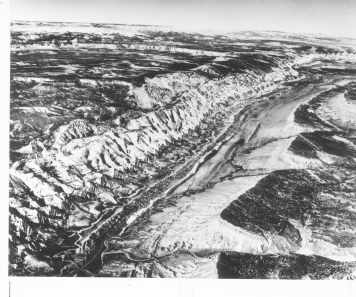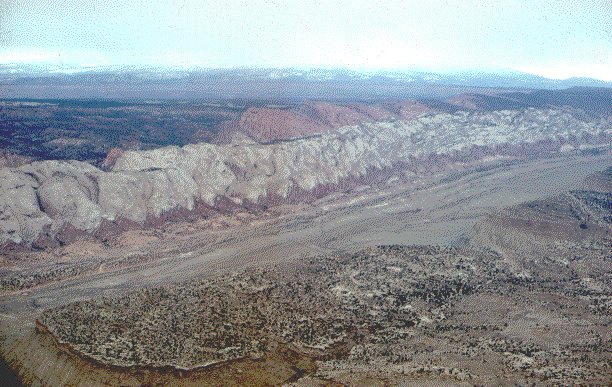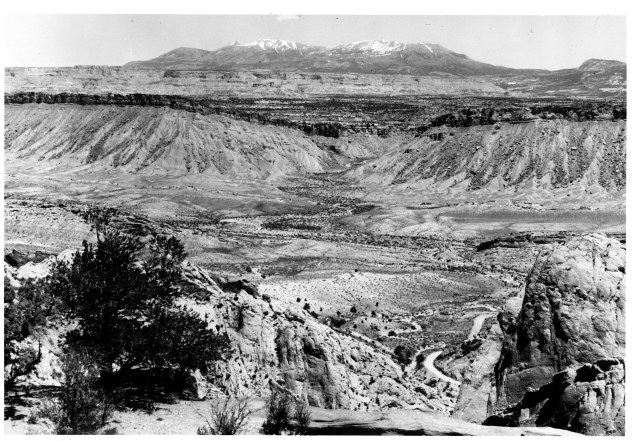
In the Plateau, there is one structural exception to this. In places, the rocks may be gently folded in broad warps called anticlines and synclines, in which rock layers become inclined (are said to dip) in opposing directions. Even more common are a type of folds called monoclines.
The scene below is a beautiful Landsat MSS full scene taken on June 13, 1977 that shows the northwestern section of the Colorado Plateau - including parts of the so-called Canyonlands.

Most of the upper scene lies in Utah but the lowermost areas fall within northern Arizona. Passing through the scene is the Colorado River that, backed up from the Glen Canyon Dam (lower left) near Page, fills the steep-walled canyons to form Lake Powell. The San Juan River joins the Colorado from the east. The prevalent yellow color in this image (printed on Cibachrome, which improves both color quality and definition of features) corresponds mainly to sandstones and some shales that are reds and oranges in nature. The brown tones are associated with rocks that are dark reds and browns in the field; some are tinged with reds in the image owing to vegetation in this IR version. Blues associate with shales that in the field are often grayish. Areas with strong red (IR) tones include the Abajo Peaks (upper right), the Henry Mountains (upper left), and the smaller, isolated Navajo Mountain east of Lake Powell. The northernmost end of the forested Black Mesa appears along bottom center. The cluster of brownish isolated mountains to its north are the collection of mesas and buttes - erosional remnants of red and brown sandstone-capped hills, making up Monument Valley, popular as a scenic backdrop in many classic Westerns (a favorite haunt of John Wayne) and present day TV ads. Compare the ground appearance of these striking prominences (start looking for them in the commercials, especially for autos) with their Landsat expression.

Along the right side of the image is a long band of folded rocks that comprise Comb Ridge. In the upper left is the monoclinal fold known as the Waterpocket Fold, the topic of the next few pages of Section 2. The black line across it delineates the flight path of the aircraft mission flown by NASA for this writer, as discussed in the next several pages.
In a monocline, forces cause rocks to change their inclination in only one direction and then resume the initial direction, as depicted in this sketch

which presents a side view (as though along a vertical cut into the earth) of a monocline. At the top is a line which represents a profile of the ground surface. At B, above the inclined layers, rocks that are more resistant to erosion are shown as ridges (often called "hogbacks" or "flatirons"). At A, a rock unit labelled X lies just beneath the surface but at B it has dipped downward such that it is now well below the ground. A unit labelled Y at C is well on top of X (these and rocks in between follow the stratigraphic Law of Superposition which states the obvious: younger rocks are deposited on [and thus rest above] older rocks). If one follows Y to the left along a dashed line, it bends upward at B and also lies above the ground at A; in other words, it was once there but has now been removed by erosion.
This is the situation at the Waterpocket Fold, which runs across this subscene. A black & white view

followed by a color view, both taken looking

to the northwest from low-flying airplanes show a hogback ridge dominated by a whitish unit, the famed Navajo Sandstone (the principal rock formation at Zion National Park) and several other (reddish) units near its base. The thick red unit beyond (west) the Navajo is the Wingate Formation. These several units dip at angles as steep as 45 degrees. Younger gently dipping rocks (equivalent to C) in the foreground below the Tarantula Mesa are actually higher in elevation. Older rocks (equivalent to A) can be barely seen below the distant horizon; these make up the Circle Cliffs. A third aerial view taken from the west side of the fold looking

to the northeast, shows these older rocks to the left and younger rocks in the distance, with the Fold itself again highlighted by the Navajo Sandstone and standing out as a narrow band of outcrops along the structurally- controlled topographic ridge. Now, take two close up looks from the ground, one looking up against the Fold

with the Navajo Sandstone near the top and the Entrada Sandstone (reddish) below it but stratigraphically younger; the second looking eastward

at Tarantula Mesa with the Mesaverde Sandstone capping the mesa and the Dakota Sandstone as blocks in the foreground, with the famous Henry Mountains (where Gilbert conceived the idea of a laccolithic intrusion) against the skyline.
Code 935, Goddard Space Flight Center, NASA
Written by: Nicholas M. Short, Sr. email: nmshort@epix.net
and
Jon Robinson email: Jon.W.Robinson.1@gsfc.nasa.gov
Webmaster: Bill Dickinson Jr. email: rstwebmaster@gsti.com
Web Production: Christiane Robinson, Terri Ho and Nannette Fekete
Updated: 1999.03.15.